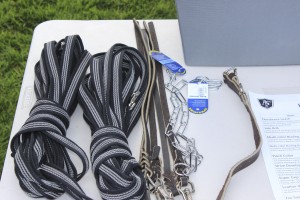Bonding Basics
 Whether you are an experienced dog owner or owning a dog for the first time, there are various techniques for building a strong bond with your puppy or dog. The most valuable asset you can provide your new family member is “time.” With puppies, time is of the essence. Dogs bond the strongest with humans between ages 8 to 16 weeks. It is important to remember that puppies mature faster than humans do. While the first few weeks with your dog may seem like a short amount of time, the first few weeks are vital to your dog’s training and overall obedience. In turn, avoid boarding or having family or friends puppy-sit during this period. Failing to maximize your bonding during this critical phase will force the puppy to suffer in the long run.
Whether you are an experienced dog owner or owning a dog for the first time, there are various techniques for building a strong bond with your puppy or dog. The most valuable asset you can provide your new family member is “time.” With puppies, time is of the essence. Dogs bond the strongest with humans between ages 8 to 16 weeks. It is important to remember that puppies mature faster than humans do. While the first few weeks with your dog may seem like a short amount of time, the first few weeks are vital to your dog’s training and overall obedience. In turn, avoid boarding or having family or friends puppy-sit during this period. Failing to maximize your bonding during this critical phase will force the puppy to suffer in the long run.
Health and Nutrition
As a new dog owner it is your responsibility to keep your dog healthy. I recommend after getting your new puppy or dog that you take him to meet your vet. This is important for several reasons. First, it is good for the puppy to meet your vet and begin a relationship between you, your dog, and veterinarian. Second, the veterinarian will make sure the puppy/dog is in good health. Most of the time dog owners are immediately able to determine when their dog may be sick by their attitude. A healthy dog is generally alert and ready to train.
Nutrition is a tricky topic to provide tips on. I always start by recommending brands to new dog owners. In reality, every veterinarian and dog trainer has their own preference of what they feel is “the perfect diet.” However, I recommend Diamond Naturals puppy/dog food, which you can get at most pet stores. I also supplement dry dog food with raw meat as well. Most butcher shops have a good dog blend. Check with your veterinarian to see if a raw meat supplement is right for your dog.
Exercise
The term “exercise” can trick you as a dog owner. Exercise is not necessarily just running on a treadmill. Most owners think throwing a ball with a chuck-it toy 50 yards for 30 minutes is exercise for their dog. Although it helps with cardiovascular endurance, if the goal is to provide your dog with the most meaningful exercise in the most limited amount of time, then that is not it.
So what is the key? Imagine you are running on a treadmill and I give you a 50 question trigonometry test. In this scenario you are being taxed physically and mentally simultaneously. Your dog requires the same simultaneous exertion daily. I understand we all work long days and want to be good dog owners and I’m often asked how you can give your dog the “Trig and Treadmill” exercise needed for a healthy dog. The answer is obedience. Instead of throwing the ball for an hour challenge, your dog with “meaningful” obedience. You will notice your dog will be less anxious and of course “better trained.”
For puppies, it is important not to over work them. Remember their bodies and nerves are still under development. For most breeds, you should not be taking them on long runs until they are more than one year old. This will limit the amount of continuous grinding of the hips, elbows and other joints still under development.
Tools
-Collar
-Leash
-Dog Treats or Hot Dogs
-Dog bowls for water and food
-Crate (optional)
-Puppy bed or blanket
-Puppy toys and tugs


